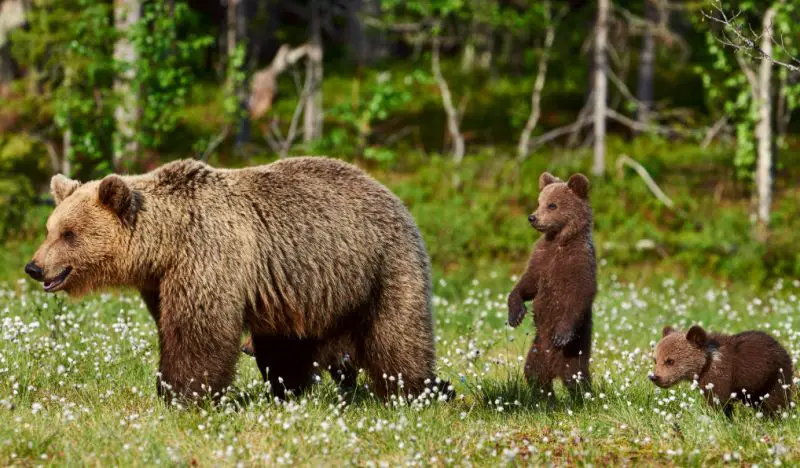Montana, known as “Big Sky Country,” is home to one of the most iconic predators in North America: the grizzly bear (Ursus arctos horribilis). Once widely distributed across the western United States, grizzly bears were pushed to near extinction due to human expansion, hunting, and habitat loss. Today, thanks to decades of conservation efforts, Montana hosts a thriving population, making it one of the best places in the continental United States to observe these majestic creatures in their natural habitat. Grizzly bears in Montana are not only a symbol of wildness and resilience but also an important part of the region’s ecological balance, influencing everything from prey populations to vegetation patterns.
Grizzly bears are often mistaken for black bears, but there are distinct physical and behavioral characteristics that set them apart. Understanding their traits, habits, and preferred environments is essential for anyone hoping to observe them safely and responsibly. Montana’s grizzlies live across diverse ecosystems, from alpine slopes and lush meadows to dense forests and river valleys, providing a fascinating glimpse into the adaptability of this powerful species.
Physical Characteristics and Identification

Grizzly bears are renowned for their imposing size, muscular build, and the pronounced hump of muscle over their shoulders. This shoulder hump is one of the most distinctive features, supporting powerful forelimbs used for digging, foraging, and hunting. Their fur is typically brown with a mix of lighter tips that give them a “grizzled” appearance, although coloration can range from almost blonde to nearly black. The face is usually lighter than the body, with a dished profile and a broad muzzle that aids in smelling food from great distances.
Adult male grizzly bears, often called boars, are significantly larger than females. Males usually weigh between 400 and 790 pounds, while females typically range from 290 to 400 pounds. Body length ranges from six to eight feet for adults, and height when standing on hind legs can exceed eight feet, creating an awe-inspiring presence. Their paws are broad and equipped with long, curved claws that are ideal for digging up roots, tearing logs apart to find insects, and catching fish.
Identification also relies on behavioral cues. Grizzly bears often leave evidence of their presence, such as claw marks on trees, dug-up roots, overturned logs, and scat containing partially digested berries, hair, or bone fragments. These signs, along with tracks that show large front paws and a slight toe spread, help researchers and wildlife watchers distinguish grizzlies from other wildlife.
Behavior and Social Dynamics
Grizzly bears are primarily solitary creatures, with the exception of mothers raising cubs or temporary gatherings around abundant food sources, such as salmon streams or berry patches. Social interactions are generally limited to mating or territorial disputes. Despite their size, grizzlies are highly adaptable and intelligent, capable of modifying their behavior based on food availability and environmental conditions.
These bears are most active during daylight hours but can be nocturnal in areas where human activity is frequent. In spring and early summer, grizzlies often roam widely in search of high-calorie foods, while in late summer and fall, they focus on fattening up for winter hibernation. They are known to be protective and aggressive, particularly females with cubs, but will usually avoid confrontation with humans if given adequate space.
Grizzly bears communicate using vocalizations, body language, and scent marking. Growls, huffs, and jaw pops are common warning signs, while rubbing against trees or rolling in scent-marked areas conveys dominance or territory information. Observing these behaviors can provide valuable insights for wildlife enthusiasts and researchers alike.
Diet and Feeding Habits
Grizzly bears are omnivorous, with one of the most diverse diets among North American mammals. Their diet includes berries, nuts, roots, insects, small mammals, carrion, and fish. In Montana, they are known to feed heavily on cutthroat trout during the spawning season, as well as moose calves, elk, and bison when available. Seasonal variations in diet are significant; in spring, grizzlies primarily consume fresh vegetation and carrion from animals that did not survive the winter, while summer and fall are dominated by fruits, nuts, and fish that help build fat reserves for hibernation.
Their keen sense of smell, estimated to be seven times stronger than a bloodhound’s, enables them to detect food from over a mile away. Grizzly bears use their strong forelimbs and long claws to dig roots, tear logs, and overturn rocks to access hidden food. They are also opportunistic feeders, capable of raiding human food sources or livestock, which often leads to conflicts if proper precautions are not taken.
Reproduction and Lifecycle
Reproduction in grizzly bears is characterized by a slow and deliberate cycle. Females typically reach sexual maturity at around five years of age, while males mature slightly later. Mating occurs between May and July, and females exhibit a unique adaptation known as delayed implantation, where fertilized eggs do not immediately implant in the uterus. This allows the female’s body to assess if she has accumulated sufficient fat reserves to carry and nurture the cubs through winter.
Cubs are usually born in January or February during hibernation, with litters ranging from one to three offspring. At birth, cubs weigh less than a pound and are entirely dependent on the mother for warmth and nutrition. They remain with their mother for two to three years, learning survival skills such as hunting, foraging, and recognizing threats. Grizzly bears can live up to 25 years in the wild, though life expectancy is often reduced by human encounters, disease, and competition for resources.
Habitat and Ecosystems in Montana
Grizzly bears in Montana inhabit diverse ecosystems that range from dense forests and river valleys to alpine meadows and rocky highlands. They are most commonly found in areas that provide a combination of food availability, water access, and cover for denning. Early spring sees bears occupying lower elevations to access emerging vegetation, while summer drives them higher into mountainous regions where berries, roots, and fish are abundant.
Montana is home to several critical grizzly bear recovery zones, each with unique ecological features. The Northern Continental Divide Ecosystem (NCDE) spans over 9,600 square miles and is the largest contiguous wilderness in the lower 48 states, supporting more than 1,000 bears. The Greater Yellowstone Ecosystem (GYE) encompasses southwestern Montana, parts of Idaho, and Yellowstone National Park, housing roughly 700–750 bears. The Lee Metcalf Wilderness and the Bitterroot Ecosystem, while smaller, provide essential habitat for reproduction and dispersal of younger bears.
Grizzly bears are highly sensitive to human activity, so remote regions with limited human presence are critical for their survival. These areas provide safe corridors for movement, feeding, and denning. Seasonal migration patterns allow bears to optimize access to high-calorie food sources while avoiding competition and human interference.
Conservation History and Efforts
Historically, grizzly bears were widespread across Montana, but extensive hunting, habitat destruction, and human expansion caused populations to plummet by the early 20th century. By the 1930s, grizzly bears had been eliminated from much of the state’s lowland areas. Conservation efforts intensified in the 1970s, culminating in the listing of the grizzly bear as a threatened species under the U.S. Endangered Species Act in 1975.
State and federal agencies, including Montana Fish, Wildlife & Parks and the U.S. Fish and Wildlife Service, implemented comprehensive recovery strategies. These efforts included habitat protection, reintroduction programs, monitoring through GPS tracking and aerial surveys, and public education to reduce human-bear conflicts. Today, the grizzly bear population in Montana is considered stable in major recovery zones, though ongoing management is required to address habitat fragmentation and potential human-bear interactions.
Best Locations for Observing Grizzly Bears
Glacier National Park is one of the most popular and accessible locations to see grizzly bears in Montana. The park offers diverse habitats, from alpine slopes to river valleys, supporting a population of approximately 300 bears. Visitors have higher chances of spotting bears along the Highline Trail, Hidden Lake Overlook, and Logan Pass, where bears forage on berries and small mammals. Observation is safest from a distance, and visitors are encouraged to remain vigilant and follow park guidelines to avoid disturbing wildlife.
The Northern Continental Divide Ecosystem provides opportunities for more remote and secluded grizzly viewing. This area includes the Bob Marshall Wilderness, known as the “Great Bear Wilderness,” offering rugged terrain and abundant food sources. Backpacking and hiking expeditions here allow for extended wildlife observation, but safety measures such as carrying bear spray, making noise, and traveling in groups are essential.
The Greater Yellowstone Ecosystem also hosts a significant bear population, especially in the southwestern Montana portions and near Yellowstone National Park. While more difficult to access than Glacier National Park, these areas offer less crowded viewing experiences. Visitors can often observe bears fishing in rivers or feeding in meadows during the summer and fall.
Safety Guidelines and Responsible Viewing
Grizzly bears are powerful and unpredictable animals. While encounters can be thrilling, understanding and respecting their space is vital. Maintaining a safe distance of at least 300 feet is recommended, and visitors should never attempt to approach, feed, or photograph bears up close. Carrying bear spray, hiking in groups, making noise, and properly storing food are essential precautions.
Educating oneself about bear behavior can enhance the viewing experience. Recognizing warning signs, such as huffing, jaw popping, or mock charging, allows observers to react appropriately. Seasonal patterns also influence bear activity; spring and early summer bring increased movement due to foraging for fresh vegetation, while fall sees concentrated activity near berry patches and spawning streams.
Conclusion
Grizzly bears in Montana are a testament to the resilience of wildlife and the success of dedicated conservation programs. These magnificent animals continue to thrive in the state’s diverse ecosystems, captivating researchers, photographers, and nature enthusiasts alike. Observing grizzlies in the wild provides not only a rare glimpse of raw natural power but also reinforces the importance of preserving habitats and respecting wildlife. Montana remains a premier destination for experiencing grizzly bears responsibly, offering unforgettable encounters for those willing to appreciate the wilderness from a safe and respectful distance.
By understanding their physical characteristics, behavior, diet, habitat, and seasonal patterns, visitors and wildlife managers alike can coexist safely with grizzly bears, ensuring these iconic creatures continue to roam Montana’s wilderness for generations to come.
FAQs About Grizzly Bears in Montana
What types of grizzly bears are found in Montana?
Montana is home to the North American grizzly bear (Ursus arctos horribilis), known for its muscular build, prominent shoulder hump, and grizzled fur. While there are no subspecies unique to Montana, bears vary in size, coloration, and habitat depending on whether they reside in the Northern Continental Divide Ecosystem, Greater Yellowstone Ecosystem, or other wilderness areas.
How can I identify a grizzly bear compared to a black bear?
Grizzly bears are generally larger and more robust, with a noticeable shoulder hump and a dished facial profile. Their claws are longer and straighter, and their fur often has lighter tips, giving them a “grizzled” appearance. Black bears lack the shoulder hump and have shorter, more curved claws. Tracks, behavior, and body shape also help with identification.
What do grizzly bears in Montana eat?
Grizzlies are omnivores, consuming berries, nuts, roots, fish, small mammals, carrion, and sometimes larger prey like elk or moose calves. Their diet varies seasonally: in spring, they feed on vegetation and carrion, while summer and fall are dominated by fruits, nuts, and spawning fish to build fat for hibernation.
Where are the best places to see grizzly bears in Montana?
Top spots include Glacier National Park, the Northern Continental Divide Ecosystem (NCDE), and the Greater Yellowstone Ecosystem (GYE). Trails like the Highline Trail, Logan Pass, and areas near rivers or berry patches increase chances of sightings. Remote wilderness areas offer more secluded experiences for wildlife observers.
Are grizzly bears in Montana dangerous to humans?
Grizzlies are powerful predators and can be dangerous if surprised or approached. They usually avoid humans, but mothers with cubs can be defensive. Visitors should maintain safe distances, carry bear spray, hike in groups, make noise, and follow wildlife safety guidelines.
How do grizzly bears reproduce and raise cubs?
Mating occurs from May to July, and females give birth during winter hibernation. Litters usually have one to three cubs, which stay with their mother for two to three years to learn survival skills. Females have delayed implantation, ensuring cubs are carried only if the mother has enough fat reserves.
What conservation efforts protect grizzly bears in Montana?
Grizzly bears are protected under the Endangered Species Act. Conservation strategies include habitat preservation, reintroduction programs, population monitoring, reducing human-bear conflicts, and public education. Agencies such as Montana Fish, Wildlife & Parks and the U.S. Fish and Wildlife Service play key roles in maintaining stable populations in recovery zones.
When is the best time to see grizzly bears in Montana?
The best time is from late spring to early fall. In spring, bears occupy lower elevations for fresh vegetation. Summer and fall are ideal for observing them feeding on berries, nuts, and fish. Winter is the least favorable time as bears are hibernating in dens.






